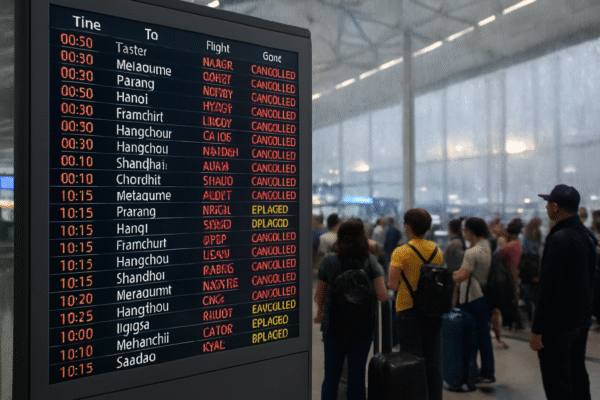UK Travellers Must Pay £17 Fee to Enter Europe as EU Rolls Out New Border Security Rules
UK citizens planning European holidays from late 2025 will need to pay a £17 travel authorisation fee and submit biometric data under sweeping changes to the European Union’s border control policies. The new measures are part of the EU’s efforts to modernise travel across the Schengen Area and strengthen external borders for non-EU nationals, including post-Brexit UK tourists.
The biggest upcoming change is the launch of the European Travel Information and Authorisation System (ETIAS) and the Entry/Exit System (EES). These initiatives aim to enhance security, reduce irregular migration, and streamline entry procedures across 30 European countries, including popular UK destinations like France, Spain, Greece, Italy, Germany, and the Netherlands.
ETIAS Fee Increased to £17 for UK Travellers
Starting between October and December 2025, British citizens who wish to travel to the Schengen Area will be required to apply for ETIAS—a visa-waiver authorisation designed for short stays of up to 90 days within a 180-day period. Previously planned to cost €7 (approximately £6), the updated fee will now stand at £17 per application.
According to the European Commission, the ETIAS aims to identify potential security, health, or migration risks ahead of travel, allowing authorities to deny entry if red flags arise. The system will apply to all visa-exempt nationals, including travellers from the UK, Canada, the United States, and Australia.
The ETIAS authorisation will be valid for three years or until the applicant’s passport expires, whichever comes first. While the fee applies to most adult travellers, exceptions exist for children under 18, seniors over 70, and family members of EU citizens who benefit from free movement rights.
Although ETIAS is not a visa, travellers will need to apply online before departure via the official portal at www.europa.eu/etias. Each traveller must submit a separate application, including children, and should expect approvals to arrive via email within 96 hours, unless further documentation is requested.
What Is the Entry/Exit System (EES)?
Complementing ETIAS is the Entry/Exit System (EES), set to go live on October 12, 2025, ahead of the UK’s half-term holiday season. This system will replace manual passport stamping with automated registration of non-EU travellers’ information at the external borders of the Schengen Area.
EES will record data such as:
- Name and travel document details
- Entry and exit dates
- Refusal of entry (if applicable)
- Biometric data: fingerprints and a facial image
These enhancements will reduce fraudulent entry, curb overstays, and speed up border checks. Once implemented fully by April 9, 2026, all British visitors will be required to undergo a biometric scan when entering Europe, whether flying, driving, or arriving by sea.
Countries Requiring ETIAS for UK Tourists
The following 30 countries within the Schengen zone will require a valid ETIAS authorisation from UK passport holders:
- Austria, Belgium, Bulgaria, Croatia, Cyprus, Czech Republic, Denmark, Estonia, Finland, France, Germany, Greece, Hungary, Iceland, Italy, Latvia, Liechtenstein, Lithuania, Luxembourg, Malta, Netherlands, Norway, Poland, Portugal, Romania, Slovakia, Slovenia, Spain, Sweden, Switzerland
This list includes both EU and non-EU Schengen members, as well as countries in the process of joining the Schengen Area.
Why Are These Changes Happening?
The reforms come as part of the EU’s Smart Borders Package, originally proposed in 2016. The aim is to ensure the bloc keeps up with rising global travel volumes while protecting against threats related to terrorism, trafficking, and illegal migration.
Post-Brexit, British citizens lost automatic freedom of movement within the EU, making them third-country nationals in the eyes of the bloc. These systems align the UK’s travel status with that of other non-EU countries, placing it under the same screening protocols.
Travel Industry Concerns and Preparation
Travel experts in the UK have raised concerns about potential delays at border crossings, especially during the initial rollout. Major airports like Heathrow, Manchester, and Gatwick are updating their check-in processes to inform passengers of the upcoming changes.
In France, the Port of Dover and Eurotunnel terminals are preparing biometric kiosks to process UK tourists more efficiently. According to GetLink, which operates the Channel Tunnel, the company is investing in infrastructure upgrades to manage expected queues during peak times.
Meanwhile, European tourism boards are encouraging travellers to stay informed and apply for ETIAS authorisation well in advance of their trips once applications open.
Official Resources for Travellers
UK citizens planning travel from late 2025 onward are advised to follow updates on these official platforms:
- ETIAS Information: https://www.europa.eu/etias
- European Commission Travel Advice: https://ec.europa.eu/home-affairs
- UK Government Foreign Travel Advice: https://www.gov.uk/foreign-travel-advice
Final Takeaway
With the upcoming introduction of ETIAS and EES, the travel landscape for UK citizens heading to Europe is about to change significantly. While the £17 fee and biometric checks may seem like added obstacles, the EU’s goal is to provide a safer and more efficient travel environment for all.
To avoid disruption and ensure a smooth journey, UK tourists are strongly encouraged to check travel documentation, monitor official announcements, and plan for longer processing times at border checkpoints. Europe remains an accessible and popular destination—but travellers must now navigate a more secure, digital border system.
For more travel news like this, keep reading Global Travel Wire


















